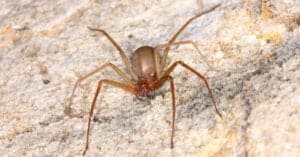
Spiders are a prevalent type of arachnid found in Virginia, with around 60 of the 3600 spider species in North America residing within the state. There are many species of brown spiders in Virginia. Brown spiders are a captivating group of arachnids that play a crucial role in Virginia’s ecosystem. Let’s dive in to learn more about these fascinating creatures.
1. Tiger Wolf Spider (Tigrosa aspersa)
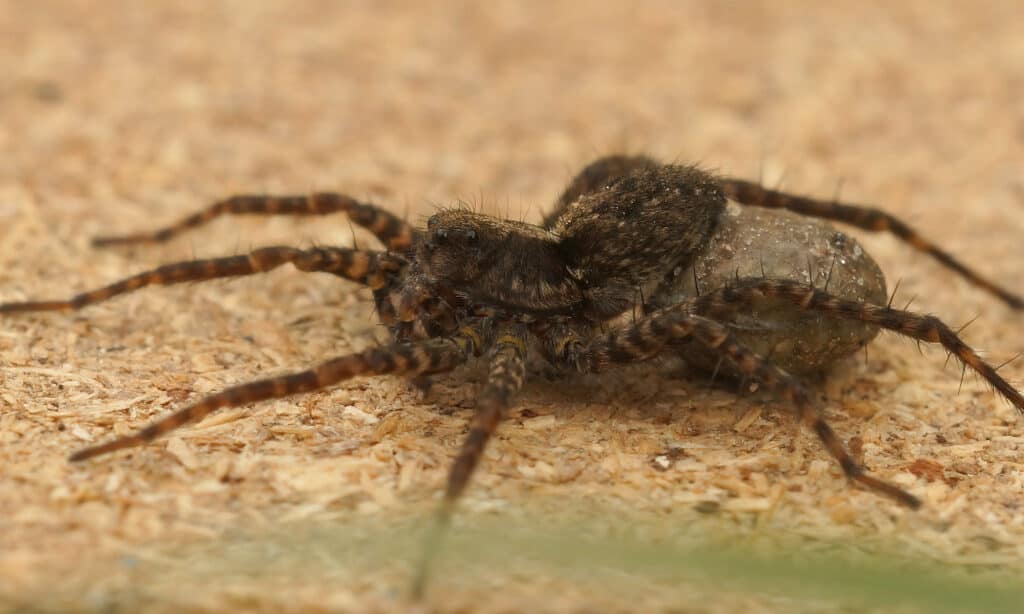
The
tiger
wolf spider is a large and intimidating-looking arachnid with a tarantula-like body that can grow up to 2 inches long.
©HWall/Shutterstock.com
In Virginia, the tiger wolf spider stands out as one of the biggest arachnids, and it’s not uncommon for people to keep them as pets due to their tarantula-like features.
Appearance
The tiger wolf spider is a large and intimidating-looking arachnid with a body that can grow up to 2 inches long. This spider species is easily recognized by its brownish orange to dark brown coloration, with stripes or bands of lighter and darker shades.
The tiger wolf spider’s legs are covered in spiny hairs that help it to move quickly and with agility.
Behavior
When approached, tiger wolf spiders tend to scurry away from humans, as they are not fond of human contact. Being hunters rather than web-spinners, they rely on their speed and agility to both catch prey and evade potential threats.
Habitat
Tiger wolf spiders inhabit a wide range of environments, including woodlands, marshes, fields, and areas near rivers or streams. These arachnids are typically found in moist habitats and tend to avoid dry environments. As a result, they prefer to reside in wetlands or riparian zones.
Eating Habits
As carnivores, wolf spiders feed on a diet consisting of insects, such as grasshoppers and ants, as well as insect eggs and other spider species. To consume their food, they inject their prey with venom and suck out their bodily fluids.
Venom
Tiger wolf spiders utilize small quantities of venom to incapacitate and kill their prey upon capture, but their venom is not lethal to humans. In the event of a bite, symptoms may only cause mild discomfort.
Fun Facts
- Tiger wolf spiders are capable of jumping.
- They carry their young on their backs.
- Wolf spiders are highly adaptable and have adapted to survive in a wide range of environments.
2. Brown Widow Spider (Latrodectus geometricus)
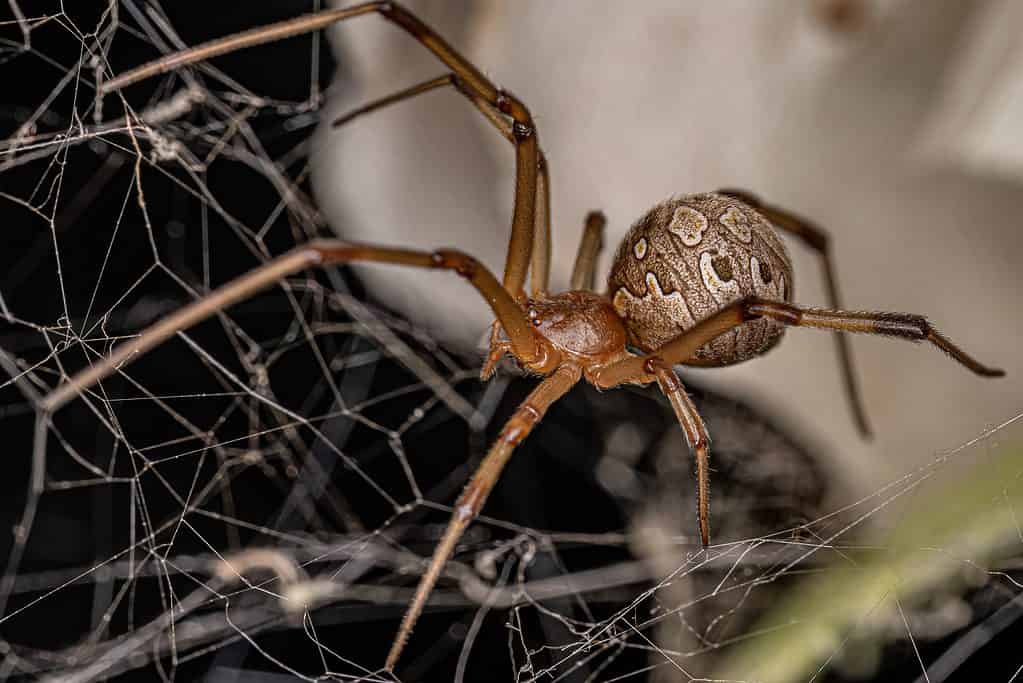
A brown widow spider’s appearance is characterized by a blend of tan and brown shades, complemented by black markings.
©Vinicius R. Souza/Shutterstock.com
While not originally from Virginia, brown widow spiders can still be spotted in the area.
Appearance
A brown widow spider’s appearance is characterized by a blend of tan and brown shades, complemented by black markings. The mature females typically sport a distinct dark stripe running lengthwise along their back and three diagonal stripes on either side of their abdomen.
When measured with their legs stretched out, adult female brown widow spiders can range from 1 to 1.5 inches in length, whereas their male counterparts tend to be slightly smaller.
Behavior
These spiders tend to exhibit non-aggressive behavior toward humans. However, they have been known to assert their dominance over black widows, often displacing them in various locations across North America.
Habitat
Brown widow spiders have been observed on numerous human-made structures, particularly in dimly lit nooks or crevices near the ground level. They can be found in and around houses, barns, fences, and any other location where a web can be spun.
Eating Habits
As with most spider species, brown widows feed on a number of insects, including crickets, flies, mosquitoes, ants, beetles, and cockroaches. These arachnids ensnare their prey by trapping them in webs, then immobilizing them by wrapping them in sticky silk. Once the prey is subdued, the spider bites and injects venom.
Venom
If bitten by a brown widow spider, the victim may experience symptoms typically similar to those of other spider bites, such as pain and redness at the wound site. While the venom of brown widow spiders is just as potent as that of black widows, they are unlikely to inject enough venom to do any real damage, so their bites are less hazardous.
Fun Facts
- Brown widow spiders are typically solitary creatures, similar to most other spider species.
- These spiders can live for up to one to two years, depending on various factors.
- Brown widow spiders possess weak eyesight.
3. Common House Spider (Parasteatoda tepidariorum)

Males may have legs with an orange hue, while female specimens display legs that appear yellow.
©Sample Stars/Shutterstock.com
Found throughout homes in Virginia, the common house spider is often confused with the brown widow due to its similar appearance.
Appearance
Common house spiders are typically brown in color with potential brown or white markings on their abdomen. Males may have legs with an orange hue, while female specimens display legs that appear yellow. The legs of the common house spider are distinctively marked with dark rings, which makes them easy to recognize.
They typically measure less than a quarter of an inch in size.
Behavior
House spiders are known for constructing webs in various locations without any particular pattern. However, if these locations do not offer any potential prey, the spiders will abandon their webs and search for a new location to build another one.
Habitat
Typically, when house spiders take up residence within homes, they tend to prefer dimly lit areas with minimal human presence. These locations include attics, closets, window frames, the corners and ceilings of rooms, as well as the spaces beneath the furniture.
Eating Habits
Common house spiders commonly trap small insects like flies, mosquitoes, ants, and fleas in their webs, and once caught, they use additional silk threads to secure them. The spider then bites the prey and injects venom to dissolve its organs, allowing the spider to consume the liquid inside.
Venom
While house spiders are venomous, they do not pose a threat to humans or pets.
Fun Facts
- A single common house spider can carry over 400 eggs.
- House spiders are capable of consuming a wide variety of insects commonly found in homes.
- Despite being effective hunters, these spiders typically weigh less than an ounce.
4. Hentz Orb-Weaver (Neoscona crucifera)
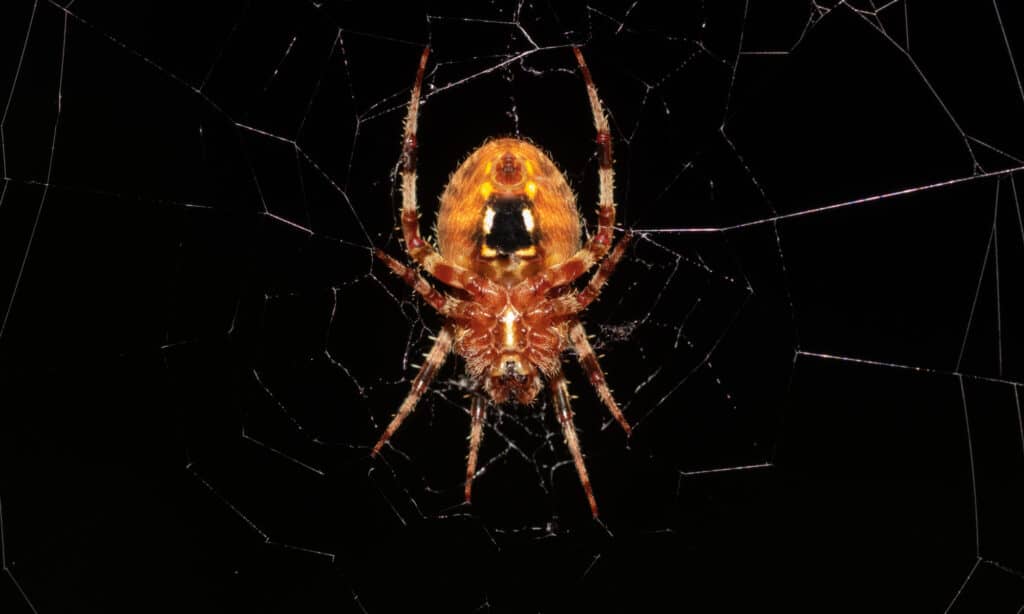
These intimidating-looking spiders construct circular webs, strategically positioned where flying insects are likely to pass.
©Christopher Troll/Shutterstock.com
Neoscona crucifera is a type of orb-weaver spider often seen in Virginia and belongs to the Araneidae family.
Appearance
Spotted orb-weavers, or Hentz orb-weavers, are named after the two white spots found on the underside of their abdomen. Additionally, their Latin name, “crucifer,” refers to the cross-shaped pattern that is raised on the top of their abdomen. These spiders typically measure around ½ inch to ¾ of an inch in size.
Behavior
Hentz orb-weavers are non-aggressive and have a docile nature. They tend to run away or drop off their web at the first sign of danger.
The spider’s daily routine involves consuming the web it had constructed the previous night and finding a hiding spot for the day. As with other orb-weaver spiders, it reconstructs a new web each night.
Habitat
While Hentz orb-weavers prefer moist woodland environments, they can also be found in a variety of other locations, such as yards, gardens, parks, and even underneath the eaves of buildings.
Eating Habits
This arachnid species is primarily active at night and relies on its nocturnal vision to capture prey. It sets up a web and waits for insects to come in contact with it either by flying or jumping.
Venom
Despite their menacing appearance, these spiders pose no threat to humans, as they lack venom. They are known to have a calm and non-confrontational temperament, and they typically avoid biting unless they feel gravely endangered.
Fun Facts
- The worldwide population of orb-weavers comprises more than 3,000 distinct species.
- Females of some species engage in post-mating cannibalism of their male counterparts.
- They construct circular webs, strategically positioned where flying insects are likely to pass.
5. Dark Fishing Spider (Dolomedes tenebrosus)
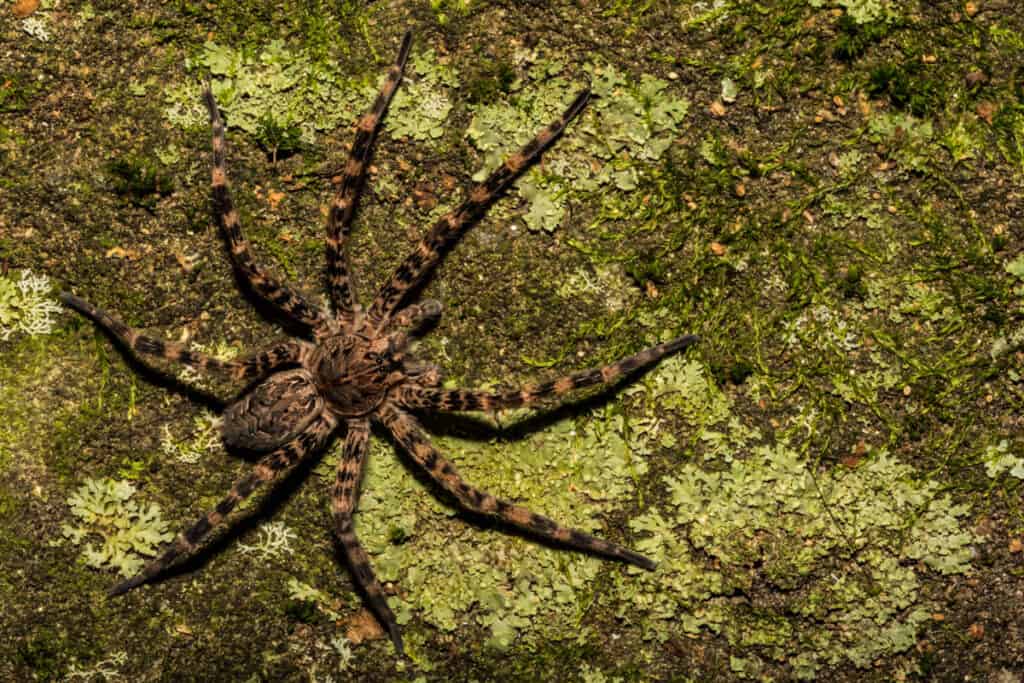
Featuring pale to dark brown hues, the spider has a distinctive appearance, with chevron markers and lighter stripes running along its legs.
©iStock.com/JasonOndreicka
The dark fishing spider, also known as Dolomedes tenebrosus, is a species of fishing spider that can be found in the state of Virginia.
Appearance
Featuring pale to dark brown hues, the spider has a distinctive appearance, with chevron markers and lighter stripes running along its legs. These legs are typically held almost straight out and are banded with a combination of brown and darker colors.
The female of the species is quite large, with a body that can measure up to 1 inch in length. But when taking the outstretched legs into account, this arachnid can be over 3 inches long. On the other hand, males are only about half the size of females.
Behavior
Similar to other members of its family, the female partakes in the gruesome act of sexual cannibalism, during which it consumes the male spider after mating.
Habitat
Despite being classified under the “fishing spider” category, not all spiders in the Dolomedes genus are strictly water-bound. In the case of the dark fishing spider, although it is commonly found in areas around rocks, shrubs, and other vegetation near permanent water, it can also be found in drier wooded areas.
Eating Habits
As the name “fishing spider” suggests, it is no surprise that this spider’s diet consists of a variety of water prey, including tadpoles, small fish, and aquatic insects. These spiders use their ability to sense vibrations, particularly those produced when their prey moves across the surface of the water, to locate and capture their meals.
Venom
Dark fishing spiders are generally known for their shy behavior and only resort to biting if it is absolutely necessary. Though their bite is not harmful, the sensation can be similar to a bee or wasp sting.
Fun Facts
- Dark fishing spiders do not spin typical webs but instead use water or moist surfaces as a substitute.
- Females can lay up to 1000 eggs at once!
- These spiders communicate through vibrations, a method known as seismic communication.
6. Brown Recluse (Loxosceles reclusa)
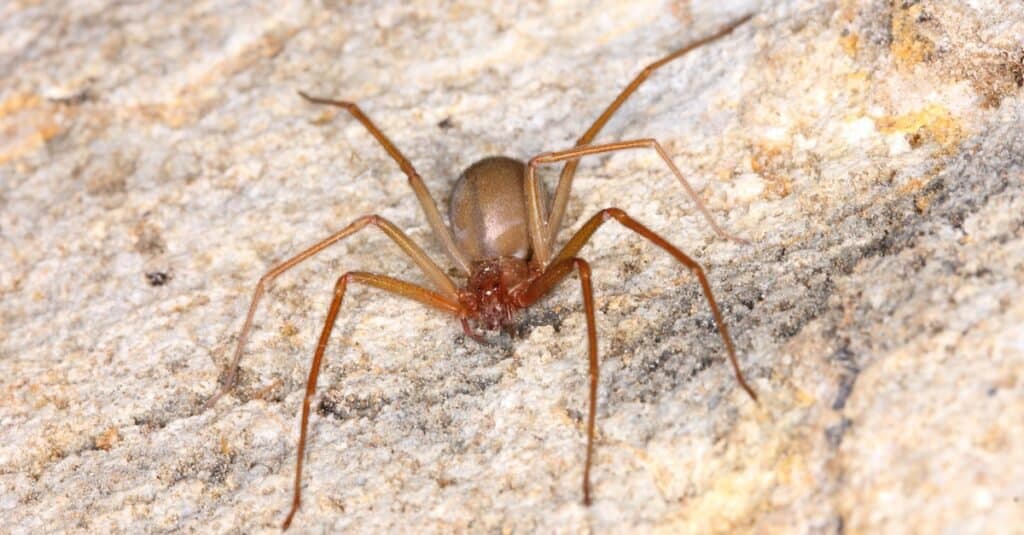
The venom of a brown recluse spider is significantly more toxic than the venom of many snakes.
©Pong Wira/Shutterstock.com
One of the most dangerous spiders found in Virginia is none other than the infamous brown recluse.
Appearance
The distinctive feature that gives the brown recluse its alternative name, the “violin spider,” is a marking on its cephalothorax that resembles the shape of a violin. This body part is broad and almost heart-shaped and is located at the front of the spider, as opposed to the abdomen.
Typically, the brown recluse spider is colored in various shades of brown and has an oblong-shaped abdomen covered with fine gray hairs.
Behavior
As a defensive measure against physical attacks, the brown recluse spider uses a strategy known as autotomy, in which it deliberately sheds one of its legs.
Unlike the huntsman spider, which can regenerate lost legs, the brown recluse spider is unable to regrow its legs back. As a result, the spider must adapt its gait to compensate for the loss of the limb.
Habitat
The brown recluse spider tends to construct its webs in locations that are dry and undisturbed, such as woodpiles, sheds, closets, garages, plenum spaces, and cellars. These areas provide the spider with the seclusion required to build its web and hunt for prey.
Eating Habits
The brown recluse spider primarily feeds on insects and occasionally consumes other spiders. It uses a chasing method to catch its prey and immobilizes it using venom.
Venom
The venom of the brown recluse spider is known to be both cytotoxic and hemolytic. It can cause significant harm to children and older people. In case of a bite from this venomous spider, it is strongly advised to seek medical attention.
Fun Facts
- Despite being a venomous spider, the brown recluse has small fangs in comparison to most spiders.
- The venom of a brown recluse spider is significantly more toxic than the venom of many snakes.
- Brown recluse spiders are predominantly active between March and October.
Thank you for reading! Have some feedback for us? Contact the AZ Animals editorial team.






